In amazing news for the science industry, 32 Australian institutions - including more than half the country's universities - have announced they're signing up to a new initiative that aims to put a stop to gender inequality in the fields of science, technology, engineering, maths, and medicine (STEMM).
Right now in Australia more than half of all science PhD graduates and early career researchers are women, but females only hold 17 percent of senior academic positions. So something is clearly holding them back from reaching these roles, and it's incredibly exciting to see so many research institutions take a stand to try to fix this problem.
The initiative is known as SAGE - or Science in Australia Gender Equity - and it will rate organisations on their gender equity policies with either a bronze, silver, or gold award, and then help them make things fairer.
The pilot is being run by the Australian Academy fo Science and the Australian Academy of Technological Sciences and Engineering, and it was inspired by the Athena SWAN gender equity accreditation program in the UK. The aim is to assess what universities and other research institutions are doing now, and then help them find better ways to promote and support women in all levels of STEMM careers.
That doesn't mean universities will have to set gender quotas or targets, but will instead look at some of the other, more subtle barriers that may be keeping women from these top jobs.
For example, it's notoriously difficult to care for a child and hold a senior research position, which involves long, irregular hours, frequent travel, and salary that's often dependent on grant applications.
And unfortunately pervasive and often unintentional sexism still exists in science, with some people having been conditioned to see women merely as lab assistants or in supportive roles, rather than as senior researchers. This was made painfully clear by the #YesAllWomen hashtag last year.
"I think it will change the gender landscape in the research sector in Australia," co-chair of SAGE Nalini Joshi, who was also the first female mathematics professor ever appointed at the University of Sydney, told Nicky Phillips at The Sydney Morning Herald.
"There is a very fat pipeline, and it has been there for some time, but as you go up the level of appointments you get fewer and fewer women," she added. "In the natural and physical sciences you see at the top of the scale, at the professorial level, something around 10 percent are female."
The SAGE initiative will help the 32 institutions involved - including universities like the University of New South Wales (UNSW) and Swinburne University, and the national science agency CSIRO - look at their data over the next two years and think about potential reasons for why there have never been female professors in some fields.
"As soon as you start drilling into the data you start to see gaps in the logic that compel an institution to ask questions like 'why have some students never been taught by a female professor'," said Joshi.
Of course the new initiative doesn't mean things are going to change overnight. But it does mean that organisations are going to take some time to think about the way they hire, promote, and support staff, and that process is likely to reveal some policies that inadvertently rule women out of top jobs. It will most likely also turn up outdated policies that are unfair for anyone, male or female, who doesn't fit the 'stereotype' of a married-to-their-job researcher.
With Nobel Laureate Tim Hunt just a few months ago telling the press that the "trouble with girls" working in labs is that they're "distractingly sexy", it's clear that this kind of focus on gender equity in STEMM can't come soon enough.
And it's not just for the sake of women who want to achieve senior positions in STEMM - making the field more fair for talented thinkers of all walks of life, genders and backgrounds to reach senior roles is going to result in incredible innovation.
"Not only is this inherently inequitable and unfair, the loss of women from science also represents a very substantial cost to Australia in training, talent and opportunities for scientific innovation," Andrew Holmes, the president of the Australian Academy of Science, told The Sydney Morning Herald.
We couldn't agree more. Well done to all the organisations involved.
